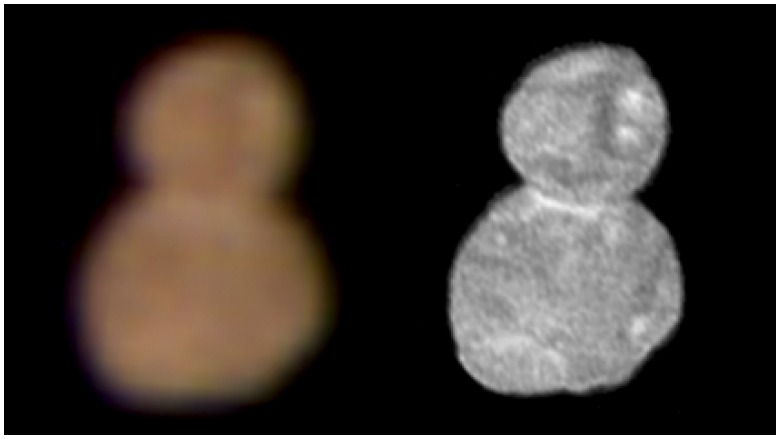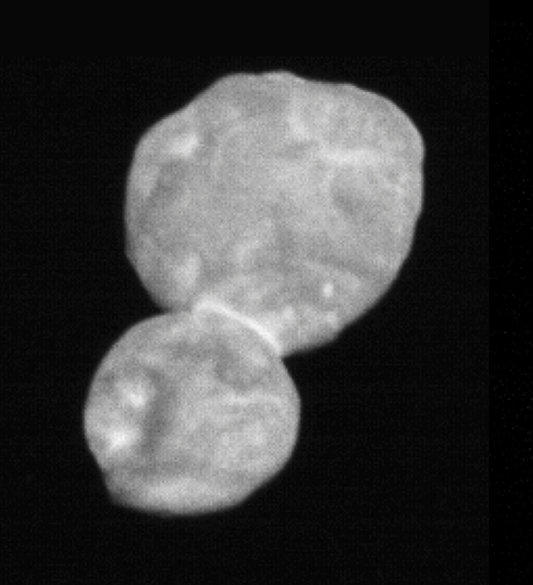
(Getty) Ultima Thule
On New Year’s Day, 2019, an interplanetary spacecraft called New Horizons had a historic encounter with a remote world. It sounds like something out of a science fiction story, but it isn’t. New Horizons, an unmanned NASA spacecraft, was out exploring Kuiper Belt, which is a region of icy bodies just past Pluto. The spacecraft flew past a remote space object known as Ultima Thule, took pictures, and collected data which it sent back to NASA scientists.
Now, scientists have analyzed the data and produced what they say is a fuller picture than we’ve ever had of the most remote world ever studied. Here’s what you need to know about Ultima Thule:
1. Some People Are Angry About the ‘Nazi’ Legacy of Its Name
Ultima Thule has a scientific name: the remote object is known as 2014 MU69. Since that’s not a very catchy name, NASA also decided to give it a nickname. They eventually settled on Ultima Thule. The name itself probably dates back about a thousand years and has been used in Latin literature. It’s historically been used to describe remote, hard to reach places.
But in the twentieth century, the name became associated with White Supremacists and Nazis. In Hitler Germany, members of the Nazi Party started talking about an imagined land of Aryan purity which they called Ultima Thule. The name still carries Nazi associations. A Swedish rock band with links to neo-Nazis named itself Ultima Thule. And a group of white supremacists in Portland, Oregon produced a newspaper full of racist, anti semitic articles which they called Thule.
Alan Stern, the lead scientist on the New Horizons mission, said that NASA wanted to reclaim the ancient name:
“I think New Horizons is an example, one of the best examples, in our time of raw exploration, and the term Ultima Thule—which is very old, many centuries old, possibly over 1,000 years old—is a wonderful meme for exploration,” Stern said. “And that’s why we chose it. And I would say that just because some bad guys once liked the term, we’re not going to let them hijack it.”
2. Its Body Looks Like a Gigantic Snowman
Ultima Thule has been compared to a gigantic, flattened snowman. Its “head” is known as Thule, and its flattened, round-ish body is called “Ultima.” The remote space object is located in the icy reaches of Kuiper Belt, past Pluto. It’s so far away from the sun that it doesn’t receive light, or heat. Ultima Thule does orbit the sun, but the process is long, and slow; it takes Ultima Thule 293 years to make it once around the sun.
Scientists say that they’ve never seen any space object with such a strange shape — and in fact, Ultima Thule is making them re-evaluate what they know about space rocks. New Horizons chief Alan Stern said, “It is sending the planetary science community back to the drawing board to understand how planetesimals — the building blocks of planets — form.”
3. Ultima Thule Was Formed When Two Rocky Space Bodies Merged
Ultima Thule consists of two space objects that merged at some point in the past. The “head,” or smaller object, is known as “Thule,” and the larger, flatter part is called “Ultima.” Scientists say that they two bodies were formed by a gentle collision between the two bodies. They say the collision was probably so peaceful that there was no damage done to either body. In fact, some writers have compared the merging of the two bodies to an “eternal hug” between two icy objects, far out beyond the warmth of the sun.
Here’s how scientists describe the formation of Ultima Thule:
“All available evidence indicates that MU69 is instead the product of a gentle collision or merger of two independently formed bodies, possibly contacting one another at (or more slowly than) their mutual gravitational infall speed,” reads the paper, which is authored by New Horizons chief Alan Stern and dozens of his colleagues.
4. Its Surface Is Red, Icy & Marked With Hills & Valleys
Ultima Thule is located about 4.1 billion miles from the Earth. Its surface is reddish brown (some people have compared it to a potato). It doesn’t have any satellites or rings. Its pockmarked surface has a variety of features, ranging from rolling hills to little valleys and furrows. Scientists say they’ve also seen evidence of some ice and some organic molecules on Ultima Thule’s surface, as well as some signs of methane gas.
5. More Data on Ultima Thule Is Still Coming In
The New Horizons spacecraft did a fly-by of Ultima Thule on New Year’s Day, 2019. That’s when it started sending data back to scientists on Earth for analysis. But not all the data has been transmitted yet. NASA says that the final data on Ultima Thule will reach them by mid-2020. They hope to learn more about Ultima Thule — but they also hope to learn more about how distant space objects operate and interact with each other.


